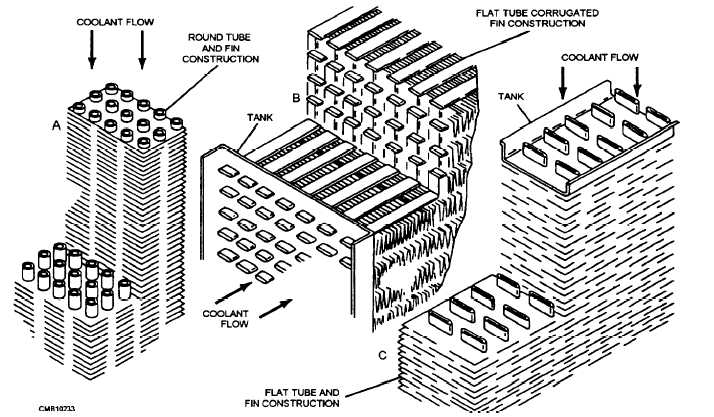lighter. This causes it to flow out of the top outlet of the engine and into the top tank of the radiator.
As the coolant is cooled in the radiator, it again becomes more dense and heavier. This causes the coolant to settle to the bottom tank of the radiator.
The heating in the engine and the cooling in the radiator therefore create a natural circulation that aids the water pump.
The amount of engine heat that must be removed by the cooling system is much greater than is generally realized. To handle this heat load, it may be necessary for the cooling system in some engine to circulate 4,000 to 10,000 gallons of coolant per hour. The water passages, the size of the pump and radiator, and other details are so designed as to maintain the working parts of the engine at the most efficient temperature within the limitation imposed by the coolant.
Radiator
In the cooling system, the radiator is a heat exchanger that removes the heat from the coolant passing through it. The radiator holds a large volume of coolant in close contact with a large volume of air so heat will transfer from the coolant to the air. The components of a radiator are as follows:
CORE - The center section of the radiator made up of tubes and cooling fins.
TANKS - The metal or plastic ends that fit over core tube ends to provide storage for coolant and fittings for the hoses.
FILLER NECK - The opening for adding coolant. It also holds the radiator cap and overflow tube.
OIL COOLER - The inner tank for cooling automatic transmission or transaxle fluid.
PETCOCK - The fitting on the bottom tank for draining coolant.
A tube-and-fin radiator consists of a series of tubes extending from top to bottom or from side to side (fig. 6-5). The tubes run from the inlet tank to the outlet tank. Fins are placed around the outside of the tubes to improve heat transfer. Air passes between the fins. As the air passes by, it absorbs heat from the coolant. In a typical radiator, there are five fins per inch Radiators used in vehicles that have air conditioning have seven fins per inch. This design provides the additional cooling surface required to handle the added heat load imposed by the air conditioner.

Figure 6-5. - Engine radiator construction.
Continue Reading